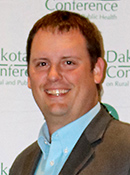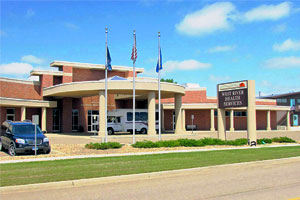CEO Turnover in Rural Hospitals
By Jena Pierce on

NRHA Policy Paper
 Shahan is
also a National
Rural Health Association (NRHA) Fellow. NRHA's
Rural Health Fellows Program is a yearlong, intensive
training program that develops leaders who can articulate
a clear and compelling vision for rural America. The
program is set up to educate and orient new
administrators to policy development. The platform helps
build leaders for the future, and one of the objectives
is to have fellows write policy papers that could
potentially be used to help shape future federal policy.
Shahan is
also a National
Rural Health Association (NRHA) Fellow. NRHA's
Rural Health Fellows Program is a yearlong, intensive
training program that develops leaders who can articulate
a clear and compelling vision for rural America. The
program is set up to educate and orient new
administrators to policy development. The platform helps
build leaders for the future, and one of the objectives
is to have fellows write policy papers that could
potentially be used to help shape future federal policy.
Shahan and Mellie Bridewell wrote a paper titled Rural Hospital CEO Turnover. Bridewell, also a NRHA Fellow, is CEO of Arkansas Rural Health Partnership, a public nonprofit comprised of 14 rural hospital members and two Federally Qualified Health Centers spanning south Arkansas.
CEO turnover rates average 18 to 20 percent per year, with turnover rates as high as 30 percent in some states.
There has not been much research or data on rural hospital CEO turnover, but people are beginning to realize it is important, especially to smaller facilities. According to the policy paper, "The need for strong and steady leadership has never been greater, yet turnover rates for top executives in America's hospitals are high. CEO turnover rates average 18 to 20 percent per year, with turnover rates as high as 30 percent in some states, according to a report by the American College of Healthcare Executives."
"While leadership is not the sole factor in a hospital's success or failure," said Shahan, "the smaller the facility, the bigger the impact a positive or negative leader can have on the success of the hospital."
A few groups have begun to study the issue, and Shahan and Bridewell spent a lot of time interviewing CEOs. Shahan has midwest relationships, and Bridewell has southeast relationships, so they were able to talk to a variety of groups that focus on the topic of CEO turnover.
Challenges
 Shahan has been the CEO at
WRHS for almost five years. He previously served in a
role at the hospital in the information technology
department, then left for a couple years before applying
for the CEO position. That local and organizational
knowledge helped prepare him for the new position. He
knew what issues to expect.
Shahan has been the CEO at
WRHS for almost five years. He previously served in a
role at the hospital in the information technology
department, then left for a couple years before applying
for the CEO position. That local and organizational
knowledge helped prepare him for the new position. He
knew what issues to expect.
"There is a saying in rural health," he shared, "'If you've seen one Critical Access Hospital, you've seen one Critical Access Hospital.' You can't pool them all together."
"We tried to highlight the importance of mentorship," he continued. "Even before COVID-19, four or five times a week I would reach out to another CEO and ask 'have you ever gone through this, and how did you handle it,' and I get those same types of calls."
The paper references that often CEOs do not have someone helping train them or offering advice on their performance, and they might be open to working with a coach or mentor to help develop their leadership abilities and help with challenges. Available resources such as NRHA or hospital associations can help prevent rural hospital CEO burnout and provide additional peer support.
Community-Minded
We are the economic driver behind our community.
"Not only is it important to be a strong leader for the hospital," said Shahan, "but we (the facility) are typically the largest employer in our community. We are the economic driver behind our community. At WRHS we employ 240 staff. If we are not succeeding, our community is not succeeding. That is one of the biggest pieces of this role. It is really important for the leader to be community-involved and community-minded and to remember you are here to serve the members of the community. Our communities need us to serve their needs."
"For incoming CEOs," Shahan continued, "they often want to hit the ground running and make an impact, but all people really care about is if you care to get to know them. Coming into a new role, in a new community, the biggest thing you can do, and the most challenging in rural, is to try to get to know as many people as you can, try to get involved in the community."
Training and education are also valuable tools, not only for CEOs, but also for the facility's board of directors. One state has even begun requiring and financing training opportunities after realizing poor leadership can lead to the poor performance of a hospital.
"This year [2020]," the paper stated, "the state of Georgia began requiring hospital executives and board members at most of the state's rural hospitals to receive training on subjects like financial management and strategic planning to improve their decision-making and prevent their hospital's future decline."
Board Relationship
"Taking matters one step further," the paper continued, "rural facilities also need an educated, well-informed, and engaged board of directors. Boards are typically unpaid positions at nonprofit hospitals, and requiring continuing education is often a reason to not join or maintain memberships on rural boards."
The board of directors is there for governance, and the CEO is responsible for operations. It is easy for the board to want to set a direction that the CEO doesn't believe the organization can go. CEOs can struggle when the board wants to move in another direction.
"For our board," Shahan said, "we try to have people that represent our entire service area. We have business owners, entrepreneurs, retirees, homemakers, a wide-ranging representation to those we serve. Bank presidents, retired teachers, current teachers, farmers, ranchers, across the board."
"The education of the board is incredibly vital to the success of the organization," he continued. "Healthcare is extremely complex. How do we expect volunteers who go to a meeting once or twice a month to grasp it and make educated decisions on the future of the organization without providing some form of education?"
North Dakota is unique because there is a law in the Century Code that states you cannot spend more than a specific amount for nonprofit boards. Taking members to a national conference, which could include registration, travel, and lodging, can be expensive. In-state training opportunities have been valuable, including programs run through the Center for Rural Health.
"We have to get creative in providing some of these opportunities," Shahan said. "Some of the rural North Dakota hospitals have talked about going in together to get our boards trained. The intent of the law was good, you don't want to incentivize volunteers, but there have been some unintended consequences."
During a time when many people around the world have found working remotely to be a successful alternative, more training opportunities have become available virtually, cutting down costs and time for travel. Board meetings at WRHS have been held remotely since last April.
"All of the meetings within our facility are done over Zoom if we do not have to be in the same room," explained Shahan. "There is great opportunity with the technology that is available. Business goes on whether it is in person or virtual, and it is still important to do the education and keep everything moving forward or else you become stagnant. "
Succession Planning
Succession planning is another important aspect examined in the paper. In a small rural community, what happens to a facility if the board decides to part ways with the CEO or the CEO decides to leave?
Succession planning for C-suite positions is key to organizational success.
The paper quoted one of the sources interviewed, Deborah J. Bowen, president and CEO of the American College of Healthcare Executives: "Organizational restructuring, the movement of CEOs to different positions within health systems, and the fact that many CEOs are reaching retirement age all contribute to this high level of turnover in hospital CEO positions. Succession planning for C-suite positions, along with a focus on developing the next generation of leaders, is key to organizational success."
Shahan believes succession planning is incredibly important and incredibly hard. In rural facilities, if a staff member could potentially be training for a future role, their current role may not be fulfilled.
"I have a documented sheet of the type of traits I believe the board should look for," said Shahan, "companies they could call and talk to, contacts in the state they could get a hold of, ideas for how to tweak the process of a search. Succession planning is so important, because if I am in a car accident tomorrow morning and there is no leader, they can't afford to wait a month before they try and fill my role. They need to have a document so they can know the facility direction and not create a concern amongst the staff."
Solutions/Recommendations
Recommendations to help lessen the likelihood of CEO burnout include:
- Focusing on board leadership
- Improving the vetting process
- Setting clear expectations
- Providing growth opportunities
- Reviewing the compensation process
- Creating a succession plan
- Utilizing third-party data sources
- Encouraging mentorship
- Providing board training
"Mellie and I really wanted the paper to highlight the success or failure of an organization can ride on the leadership or lack thereof, of this position," Shahan said. "I've had quite a few people reach out to me through LinkedIn. They read the paper and appreciated it. There have been some follow-up questions from individuals. In the end, the point of these papers is to create conversation and brainstorm and try to do better."


 is the communications manager at the Center for Rural
Health at the University of North Dakota School of
Medicine & Health Sciences in Grand Forks.
is the communications manager at the Center for Rural
Health at the University of North Dakota School of
Medicine & Health Sciences in Grand Forks.



